Uncertain future: What’s next for NAIA?

MANILA, Philippines — The clamor for a new international airport that will serve the greater Metro Manila area has left a question for which no definite answer has yet been given: What about the Ninoy Aquino International Airport (NAIA)?
For Ed Monreal, general manager of the Manila International Airport Authority (MIAA) that oversees the operations of the airport, the future of the country’s primary gateway is uncertain.That is, at least until a clear plan is set in place, he tells STARweek.
With a record-breaking 42-million people using the airport last year, NAIA has long breached the 30-million combined passenger capacity of its four terminals.
 Plucked out of retirement in 2016, MIAA general manager Ed Monreal initiated measures that transformed NAIA from one of the world’s worst airports to one of the most improved in less than two years.
Plucked out of retirement in 2016, MIAA general manager Ed Monreal initiated measures that transformed NAIA from one of the world’s worst airports to one of the most improved in less than two years.And with more people expected to fly in the following years, some believe that the end is in sight for the airport.
From world’s ‘worst’ to ‘most improved’
The surge in the number of airline passengers has resulted in problems that have hounded airport authorities for years: delayed flights, long lines, crowds and even taxi drivers making a killing with overpriced rates.
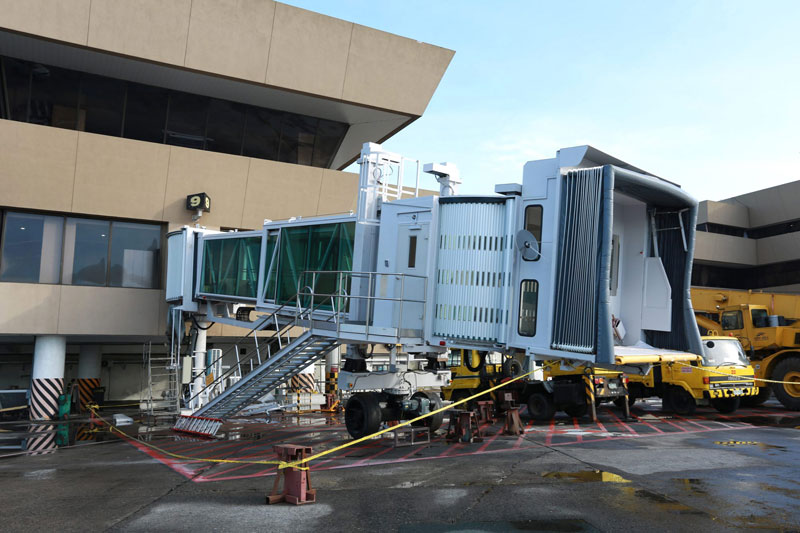 One of the new aerobridges installed at NAIA I
One of the new aerobridges installed at NAIA IFor three consecutive years, between 2011 and 2013, NAIA was named the world’s worst airport by a survey conducted by The Guide to Sleeping in Airports. It landed fourth in 2014 and fifth in 2016.
Issues cited by travelers include horrible transportation services, poor customer service and, in some years, leaking ceilings and the infamous tanim bala (bullet planting) scam.
These challenges, which may have led some quarters to consider NAIA a lost cause, did not stop Monreal from accepting the job to run the airport in 2016.
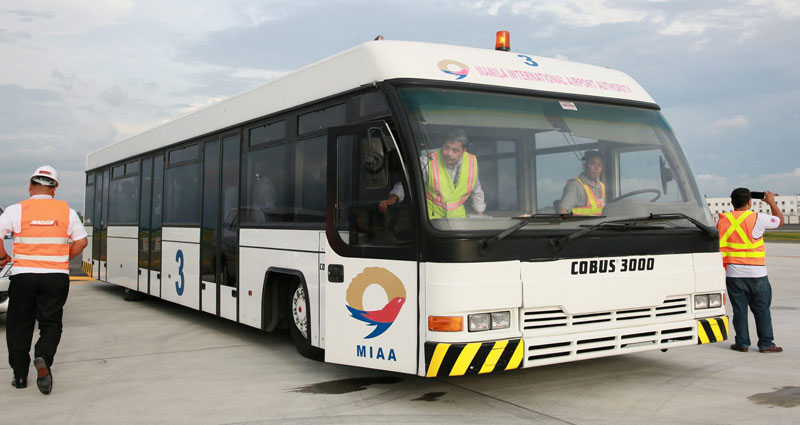 Buses to take passengers from planes using the new rapid exit taxiways help improve runway occupancy time for departing airplanes.
Buses to take passengers from planes using the new rapid exit taxiways help improve runway occupancy time for departing airplanes.Plucked out of retirement by Transportation Secretary Arthur Tugade, Monreal had almost four decades of experience in the aviation industry that he brought with him to MIAA.
“It was something that I saw as giving back to the community. It’s the airport where I came from, I stayed there for almost 37 years,” he says.
“I moved around with Cathay (Pacific) and retired as a station manager in 2014. And then two years later, there came the opportunity. I said, why not try? I came from the airline, now I become a regulator. I can probably see what the airlines and the passengers are looking for,” he adds.
Two years into his term, NAIA is officially out of the world’s worst airport list. It also ranked 10th in the list of most improved airports by London-based Skytrax.
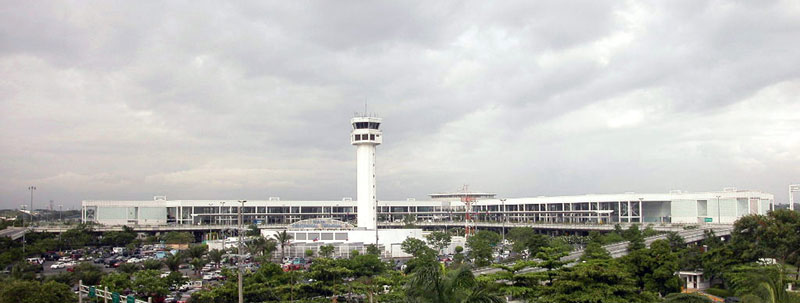 The NAIA terminal has long exceeded its intended capacity.
The NAIA terminal has long exceeded its intended capacity.But how did he do it?According to Monreal, the departure of NAIA from the world’s worst list is a result of various initiatives, including the rehabilitation of the terminals initiated by the previous administration.
But in addition to aesthetic improvements, the MIAA general manger notes their efforts to address issues such as flight delays and traffic congestion, which are among the major concerns of passengers.
“We were able to bring it down to the barest minimum,” he says, referring to delays. “At some point, we put out orders in terms of the operations of the airport. We see to it that the airlines follow that.
”He cites a stricter policy for departures, noting that planes used to secure clearance even if they are not yet ready for takeoff. “Now, you have to be ready within five minutes. Otherwise, you will have to wait in line again.
”Given the huge passenger volume at NAIA, Monreal admits that there is little room for improvement in terms of capacity-related issues. But there are some things that they are doing.
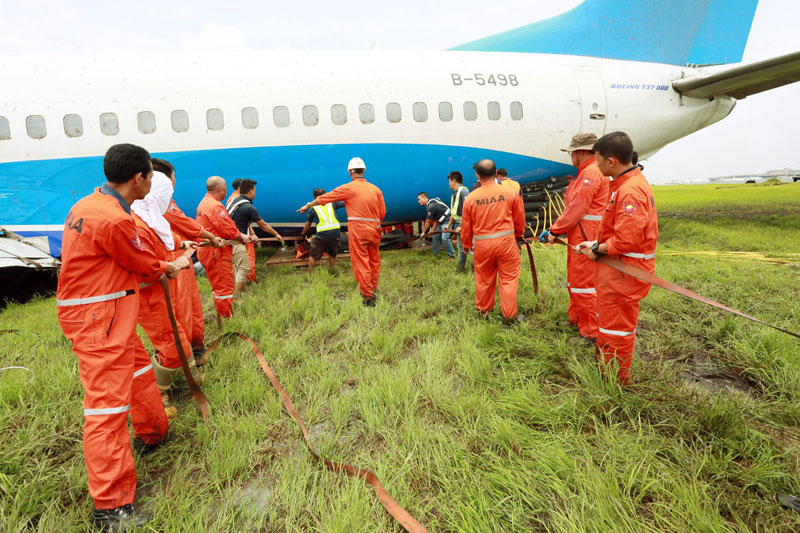 MIAA personnel remove the Xiamen Air plane the skidded off the runway on Aug. 18.
MIAA personnel remove the Xiamen Air plane the skidded off the runway on Aug. 18.“Increasing capacity will require space, a new terminal or facility. But there’s still room to operate for extra capacity (in NAIA). There are still open slots (for arrivals and departures) in the early morning, in the evening. There’s still opportunity,” he says.
Monreal says they have also embarked on efforts to address other problems, including lack of adequate facilities for passengers. Stricter guidelines were also implemented to improve transportation services and prevent incidents of extortion.
Other agencies have also implemented programs to transform NAIA into a world-class airport. Recently, the Bureau of Immigration installed electronic gates to lessen lines at immigration counters.
The MIAA chief said the Civil Aviation Authority of the Philippines, which is in charge of the control tower, is also in the process of transitioning into a new state-of-the-art system.
He cites his experience, as well as the support of the MIAA personnel, as among the factors that contributed greatly to the improved operations of the airport.
“It’s kind of easy for me to decide because I know both sides. I’m not really saying that I know it all. But I was there. I’ve been one of them for the past 37 years. I know the requirements of the passengers, I know the requirement of the operations of the airlines,” he says.
“The airport is basically a servant to the clients. If they have some reservations, the people who work with me, I can always explain that this is the way it should be done because I was once there,” he adds. Xiamen incident
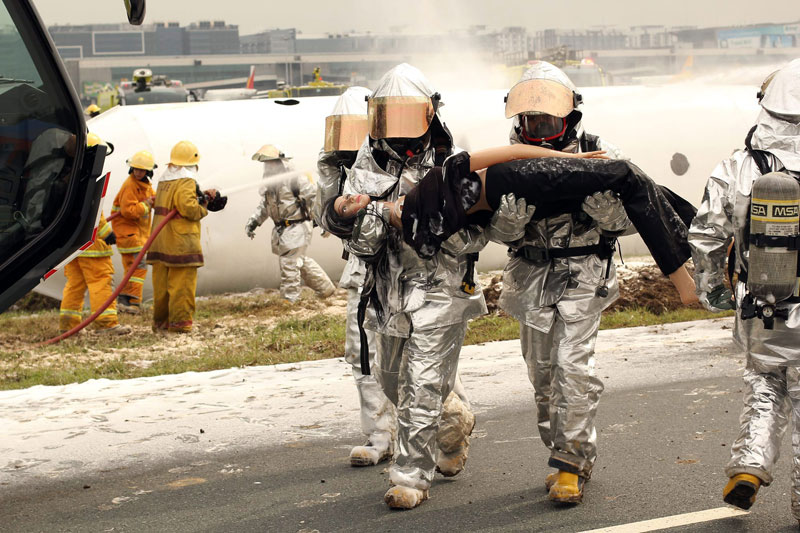 Personnel take part in drills in preparation for possible emergencies .
Personnel take part in drills in preparation for possible emergencies .Everything, however, is not a walk in the park for Monreal and his team.
Earlier this year, airport authorities drew criticism after NAIA’s operations were paralyzed due to the closure of the main runway for almost 36 hours. The culprit? A plane operated by Xiamen Air skidded off the runway due to heavy downpour before midnight of Aug. 18.
MIAA initially announced that the runway would only be closed until noon the following day. Subsequent announcements, however, extended the runway’s closure up to midday of Aug. 20.
The incident resulted in cancellation of over 600 flights, highlighting the magnitude of the problems that may arise in emergencies affecting the country’s primary gateway.
Addressing critics, Monreal says their response to the Xiamen incident was the best that they could do under the circumstances.
“It could be, from other perspectives, that it is slow. But there were also similar incidents in other countries wherein ours was slightly faster, so that is relative. Maybe they are correct that it took some time, but the point there is that the challenge that we had during that time of the retrieval was that it was no ordinary day,” he notes.
“The soil had been our challenge. It was raining day and night. We have thunderstorms, we have lighting to contend with,” he adds.
Accidents and emergencies, according to Monreal, are something that they take seriously.
He says airport personnel regularly undergo training to respond to different emergencies that may happen at the airport.
“I think one of the things that we have to be proud of is that no life was lost,” he says in Filipino. “If we made a mistake because we were rushing things, I’m not saying that we don’t need to expedite, but lives have to be spared, lives have to be protected.”To stay or not to stay?
The Xiamen incident underscored the risks of operating NAIA as the country’s primary gateway.
With the shutdown of the primary runway, the airport was left to operate with the shorter, intersecting runway that can only accommodate smaller planes.
Ideally, Monreal says airports should have two parallel runways to ensure that operations will continue in case of emergency on one of the runways. Operations-wise, having two parallel runways will also address air traffic congestion as more planes will be able to take-off and land.
The creation of a parallel third runway is part of the multibillion-peso proposal of a super consortium to transform NAIA into a world-class airport.
Submitted by a group composed of the country’s largest conglomerates, the two-phase proposal also involves the expansion of the current terminals and the construction of an integrated hub.
Monreal says the proposal, which has received original proponent status, is currently being deliberated upon at the Department of Transportation and would soon be submitted to the National Economic and Development Authority for approval.
Side-by-side with the NAIA rehabilitation proposal are talks of establishing a new airport, either in Bulacan or at Sangley Point in Cavite.
Some are still pushing for the development of Clark in Pampanga as the primary gateway.
Whatever the final decision would be, Monreal says he welcomes the invigorated discussions on airport development in the country.
“My personal view, really, even when I was still with the airline, is that it’s about time that we come up with a major airport development plan for many years ahead,” he says.
“There should be a master plan for the developments and improvements for the airports.
You cannot just have one or two, you have to make sure that it goes with the time. Because aviation is growing,” he adds.
For NAIA, he says the future remains uncertain, noting that some have predicted that it will only last for 15 more years.
“We will see in the years to come if those predictions are correct,” he says.
“There’s no plan to shut down the airport yet. There’s still life for MIAA, for NAIA. Who knows what the next direction would be?”
- Latest
- Trending


















